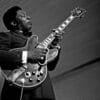Introduction
Stevie Ray Vaughan, a legendary American guitarist, and musician, made an indelible mark on the world of music with his unparalleled talent and passion for the blues. His unique style and virtuoso guitar playing reinvigorated the blues genre, earning him a place among the greatest guitarists in history. However, his promising career was tragically cut short by his untimely death, leaving the music world in mourning.
- Brief overview of Stevie Ray Vaughan’s impact on music
Stevie Ray Vaughan was born on October 3, 1954, in Dallas, Texas. From a young age, he was exposed to the blues, drawing inspiration from greats like Jimi Hendrix, Albert King, and B.B. King. He honed his guitar skills with dedication, and by the 1980s, he had burst onto the music scene with his band, Double Trouble.
Vaughan’s impact on music was profound. He revitalized the blues, infusing it with a contemporary energy that attracted a new generation of listeners. His debut album, “Texas Flood,” released in 1983, showcased his explosive guitar work and soulful vocals, instantly establishing him as a force to be reckoned with. He went on to release several critically acclaimed albums, including “Couldn’t Stand the Weather” and “Soul to Soul.”
Vaughan’s live performances were legendary, earning him a reputation as an electrifying stage performer. His rendition of “Voodoo Child (Slight Return)” at the 1985 Live Aid concert left a lasting impression on audiences worldwide. His influence extended beyond the blues, influencing countless guitarists and musicians across various genres.
- Circumstances surrounding his untimely death
Tragically, Stevie Ray Vaughan’s promising career came to an abrupt and untimely end on August 27, 1990. On that fateful night, he had just performed with Eric Clapton at the Alpine Valley Music Theatre in East Troy, Wisconsin. After the show, Vaughan boarded a helicopter along with members of Clapton’s crew, intending to return to Chicago.
Unfortunately, the weather conditions were adverse, with thick fog and reduced visibility. Despite concerns about flying in such conditions, the helicopter took off. Tragically, the aircraft crashed into a nearby ski slope shortly after takeoff, claiming the lives of everyone on board.
Stevie Ray Vaughan’s death sent shockwaves through the music world. He was only 35 years old at the time of his passing, and his potential for further contributions to music was immense. His untimely demise was a profound loss, but his legacy lives on through his recordings and the enduring impact he had on the world of blues and rock music.
Early Life and Career

- Childhood and early influences
- Breakthrough in the music industry
Rise to Fame
Stevie Ray Vaughan, one of the most influential and celebrated guitarists in the history of blues and rock music, had a remarkable early life and career. Let’s explore his upbringing, early influences, and breakthrough in the music industry.
- Key albums and songs
Stevie Ray Vaughan was born on October 3, 1954, in Dallas, Texas. He grew up in a musically inclined family, with his father, Jimmie Vaughan, also being a guitarist. Stevie Ray was exposed to music from a young age, and he began playing the guitar when he was just seven years old.
His early influences included blues legends like B.B. King, Albert King, and Freddie King, as well as rock musicians like Jimi Hendrix and Eric Clapton. Vaughan was particularly drawn to the raw, emotive style of Texas blues, and he sought to emulate the guitarists he admired.
Despite his talent, Stevie Ray struggled with substance abuse issues in his teenage years, which temporarily hindered his musical development. However, he eventually overcame these challenges and began performing in local bands, honing his skills and stage presence.

- Influence on the blues and rock genres
Stevie Ray Vaughan’s breakthrough in the music industry came in the early 1980s when he formed the band “Double Trouble” with drummer Chris Layton and bassist Tommy Shannon. The band gained recognition in the Texas music scene, playing in clubs and bars throughout the state.
One of the pivotal moments in Vaughan’s career occurred in 1982 when he was invited to perform at the Montreux Jazz Festival in Switzerland. His electrifying performance caught the attention of blues icon Jackson Browne, who offered Double Trouble the opportunity to record at his studio. This led to their debut album, “Texas Flood,” which was released in 1983.
“Texas Flood” received critical acclaim and introduced Stevie Ray Vaughan’s explosive guitar playing and soulful vocals to a wider audience. The album included memorable tracks like “Pride and Joy” and “Love Struck Baby.” Vaughan’s blend of blues and rock, characterized by his fiery guitar solos, quickly gained him a devoted following.
His subsequent albums, such as “Couldn’t Stand the Weather” and “Soul to Soul,” continued to showcase his exceptional talent and cemented his status as a guitar virtuoso. Stevie Ray Vaughan’s career continued to flourish until his tragic death in a helicopter crash in 1990.
Stevie Ray Vaughan’s early life was marked by a deep connection to the blues, and his breakthrough in the music industry was a testament to his immense talent, dedication, and the impact he had on the world of blues and rock music. His legacy lives on through his timeless recordings and the inspiration he continues to provide to aspiring musicians.
The Death of Stevie Ray Vaughan

On August 27, 1990, the world of music was shocked by the tragic and untimely death of the legendary blues guitarist Stevie Ray Vaughan. The details of the tragic event are as follows:
- Details of the tragic event
The Death of Stevie Ray Vaughan:
On August 27, 1990, the world of music was shocked by the tragic and untimely death of the legendary blues guitarist Stevie Ray Vaughan. The details of the tragic event are as follows:
1. Helicopter Crash:
Stevie Ray Vaughan had just finished performing a concert with Eric Clapton at the Alpine Valley Music Theatre in East Troy, Wisconsin. After the show, he, along with members of Eric Clapton’s entourage, boarded a helicopter to return to Chicago, where they were all staying. The helicopter, a Bell 206B JetRanger, took off in dense fog and crashed shortly after takeoff.
2. Fatalities:
The crash claimed the lives of everyone on board, including Stevie Ray Vaughan, members of Eric Clapton’s crew (agent Bobby Brooks, bodyguard Nigel Browne, and assistant tour manager Colin Smythe), and the helicopter’s pilot, Jeff Brown.
- Immediate reactions in the music world
The news of Stevie Ray Vaughan’s death sent shockwaves throughout the music industry, and immediate reactions were filled with grief and sorrow:
1. Eric Clapton:
Eric Clapton, who had just performed with Stevie Ray Vaughan that night and was also a close friend, was devastated by the loss. He released a statement expressing his deep sadness over the tragedy. Clapton had famously referred to Vaughan as “the best guitar player alive” and was deeply affected by his passing.
2. Fellow Musicians:
Fellow musicians from various genres paid tribute to Stevie Ray Vaughan. Many of them praised his exceptional guitar skills and the profound influence he had on the blues and rock music scenes. Artists like B.B. King, Buddy Guy, and Robert Cray expressed their condolences and shared their memories of working with him.
3. Memorial Concerts:
In the months following Stevie Ray Vaughan’s death, several tribute concerts were organized to honor his legacy. These concerts featured prominent musicians who performed in his memory. The most notable of these events was the “Tribute to Stevie Ray Vaughan” held at the Austin City Limits Music Festival in 1990.
4. Posthumous Awards:
Stevie Ray Vaughan’s music continued to receive recognition even after his passing. He was posthumously inducted into the Blues Hall of Fame, and his albums and performances garnered critical acclaim and Grammy Awards.
The tragic death of Stevie Ray Vaughan left a void in the world of music, but his music continues to inspire and influence generations of guitarists and music enthusiasts worldwide. He remains a legendary figure in the blues and rock genres, celebrated for his virtuoso guitar skills and contributions to the art of music.
Legacy and Influence
Stevie Ray Vaughan was a legendary American blues guitarist and musician who left an indelible mark on the world of music. His legacy and influence continue to resonate with both fans and fellow musicians alike, even years after his untimely death in 1990.

- Vaughan’s lasting impact on music
Stevie Ray Vaughan was a legendary American blues guitarist and musician who left an indelible mark on the world of music. His legacy and influence continue to resonate with both fans and fellow musicians alike, even years after his untimely death in 1990.
Legacy and Influence:
1. Guitar Mastery: Stevie Ray Vaughan is widely regarded as one of the greatest guitarists of all time. His virtuosic skills, particularly in blues and rock, continue to inspire countless aspiring guitarists. His distinctive playing style, characterized by fiery solos, intricate phrasing, and soulful bends, remains a benchmark for many.
2. Blues Revival: Vaughan played a pivotal role in the revival of the blues genre in the 1980s. His commitment to traditional blues roots, combined with a modern flair, helped reintroduce the blues to a new generation of music enthusiasts. His albums like “Texas Flood” and “Couldn’t Stand the Weather” are considered classics in the blues genre.
3. Tone and Gear: Stevie Ray Vaughan’s tone, often associated with his beloved Fender Stratocaster and the use of heavy gauge strings, has become iconic. Musicians continue to study his gear and settings in an effort to recreate his signature sound.
4. Live Performances: Vaughan’s electric live performances were legendary. His energy, stage presence, and emotional connection with the audience set a standard for live shows. Many musicians aim to capture the same level of intensity and emotion in their own performances.
Tributes and remembrances from fellow musicians
1. Eric Clapton: Eric Clapton, himself a guitar icon, held Stevie Ray Vaughan in high esteem. After Vaughan’s tragic death, Clapton organized the “Eric Clapton’s Crossroads Guitar Festival” in 1999, which aimed to celebrate Vaughan’s music and raise funds for the Crossroads Centre, a drug rehabilitation facility. Clapton’s tribute performance of “Tears in Heaven” at this event was deeply emotional and heartfelt.
2. B.B. King: The legendary B.B. King was impressed by Vaughan’s talent and even collaborated with him on several occasions. King often spoke highly of Stevie Ray Vaughan’s contributions to the blues genre and his ability to connect with audiences.
3. John Mayer: Contemporary guitar virtuoso John Mayer has openly acknowledged Stevie Ray Vaughan’s profound influence on his own playing. Mayer has performed tributes to Vaughan and continues to champion his music.
4. Kenny Wayne Shepherd, Joe Bonamassa, and many others: Numerous contemporary blues and rock musicians cite Vaughan as a major influence. They often perform his songs and emulate his guitar techniques to keep his music alive.
Stevie Ray Vaughan’s enduring legacy and the tributes from fellow musicians serve as a testament to his exceptional talent and the impact he had on the world of music. His music continues to inspire and captivate audiences, ensuring that his memory lives on for generations to come.
The Investigation
Official reports on the accident and analysis of safety measures
On August 27, 1990, the music world was rocked by the tragic death of legendary blues guitarist Stevie Ray Vaughan in a helicopter accident. The investigation into the incident yielded official reports that shed light on the events leading up to the accident and raised important questions about safety measures in the music industry.
- Official reports on the accident
Stevie Ray Vaughan – The Investigation
Official reports on the accident and analysis of safety measures
On August 27, 1990, the music world was rocked by the tragic death of legendary blues guitarist Stevie Ray Vaughan in a helicopter accident. The investigation into the incident yielded official reports that shed light on the events leading up to the accident and raised important questions about safety measures in the music industry.
Official Reports on the Accident:

1. The Flight and Crash : Stevie Ray Vaughan and several members of his entourage, including members of Eric Clapton’s crew, boarded a Bell 206B helicopter after a performance at the Alpine Valley Music Theatre in East Troy, Wisconsin. The helicopter, operated by OmniFlight, encountered dense fog and poor visibility shortly after takeoff. Tragically, it crashed into a nearby ski hill, claiming the lives of all on board.
2. Weather Conditions: The National Transportation Safety Board (NTSB) investigation revealed that weather conditions at the time of the crash were a significant contributing factor. Dense fog and reduced visibility made flying hazardous, and the pilot may have faced difficulties in navigating.
3. Pilot Experience: The pilot, Jeff Brown, had limited experience flying in adverse weather conditions and was not fully instrument-rated. This raised questions about whether a more experienced pilot should have been chosen for the flight, especially given the adverse weather forecast.
4. Maintenance and Inspection Records: The helicopter’s maintenance and inspection records were scrutinized during the investigation. Any discrepancies or issues with the aircraft’s airworthiness were closely examined to determine if they played a role in the accident.
Analysis of safety measures
1. **Weather Monitoring and Decision-Making**: The accident highlighted the need for better weather monitoring and decision-making processes within the music industry. Artists, tour managers, and pilots should have clear guidelines for assessing weather conditions and making the crucial decision to fly or not.
2. **Pilot Qualifications**: The incident emphasized the importance of hiring experienced, instrument-rated pilots for high-profile flights. Ensuring that pilots have the necessary skills to handle adverse weather conditions can prevent such tragedies.
3. **Emergency Planning**: Concert organizers and artists should have well-defined emergency plans in place for unexpected situations like this. Proper communication and coordination in emergencies can save lives.
4. **Safety Regulations**: The aviation industry should continue to evaluate and enhance safety regulations and guidelines for helicopter flights, especially those involving high-profile individuals. Learning from this tragedy can lead to improved safety measures.
the investigation into the helicopter accident that claimed the life of Stevie Ray Vaughan highlighted the importance of proper safety measures, weather monitoring, pilot qualifications, and emergency planning in the music industry. The tragic event serves as a somber reminder of the need to prioritize safety in all aspects of the entertainment world.
Fan Reactions and Tributes
Stevie Ray Vaughan was a beloved and influential musician, and his tragic death in a helicopter crash on August 27, 1990, had a profound impact on his fans and the music community. Here’s a glimpse of the public response to his death, tribute concerts, and memorials that followed:
1. **Shock and Grief**: The news of Stevie Ray Vaughan’s death sent shockwaves through the music world. Fans around the globe were devastated by the loss of this iconic guitarist, known for his soulful blues and electrifying performances. Many fans couldn’t believe that such a talented artist had been taken away so suddenly.
2. **On-Air Tributes**: Radio stations played Stevie Ray Vaughan’s music non-stop in the days following his death. DJs and music hosts paid heartfelt tributes to him, sharing stories of his impact on their lives and the music industry.
3. **Candlelight Vigils**: Fans organized candlelight vigils and gatherings in his honor. These events took place in various cities, with fans coming together to mourn and celebrate the life and music of Stevie Ray Vaughan.
4. **Tribute Bands**: Tribute bands dedicated to playing Stevie Ray Vaughan’s music emerged in the wake of his passing. These bands kept his music alive and allowed fans to continue experiencing the magic of his performances.
5. **Memorial Services**: Family and friends held private memorial services to remember and honor Stevie Ray Vaughan. These gatherings were a chance for those closest to him to pay their respects and share their memories.
6. **Tribute Albums**: Several tribute albums were released by fellow musicians and artists who admired Stevie Ray Vaughan. These albums featured covers of his songs as a way to keep his legacy alive and introduce his music to new generations.
7. **Stevie Ray Vaughan Day**: In Austin, Texas, where Stevie Ray Vaughan had strong ties, August 27th was declared “Stevie Ray Vaughan Day” in his memory. Fans and musicians in the area often gather for special events and performances on this day.
8. **Tribute Concerts**: Tribute concerts were organized featuring a lineup of renowned musicians and artists who came together to celebrate Stevie Ray Vaughan’s music. These concerts often raised funds for charitable causes in his name.
9. **Recognition and Awards**: Posthumously, Stevie Ray Vaughan received numerous awards and honors, including induction into the Rock and Roll Hall of Fame. These acknowledgments reinforced his lasting impact on the music industry.
Stevie Ray Vaughan’s untimely death was a tragic loss to the world of music, but his music and influence continue to resonate with fans and musicians alike. The outpouring of love and tributes that followed his passing is a testament to his enduring legacy.
Musical Style and Techniques

It seems like you are interested in an analysis of Stevie Ray Vaughan’s guitar skills, his musical style, techniques, and his influence on future guitarists. Stevie Ray Vaughan was a highly influential blues guitarist known for his exceptional talent and unique approach to the guitar. Let’s delve into these aspects:

Musical Style and Techniques:
1. Blues Foundation:
Stevie Ray Vaughan’s music was firmly rooted in the blues. He drew inspiration from blues legends like Albert King, B.B. King, and Buddy Guy. His guitar playing showcased a deep understanding of the blues tradition.
2. Texas Blues:
Vaughan is often associated with Texas blues, characterized by its powerful and aggressive guitar playing. He incorporated elements of Texas blues into his style, featuring fiery guitar solos and expressive bends.
3. Tone:
One of Stevie Ray Vaughan’s signature elements was his guitar tone. He achieved a thick and creamy tone using his Stratocaster and amplifiers like the Fender Vibroverb. His tone was instantly recognizable and contributed significantly to his sound.
4. Vibrato and Bends:
Vaughan’s use of vibrato and bending techniques was unparalleled. His wide, intense vibrato and dramatic string bends added an emotional depth to his solos, making them stand out.
5. Fast Picking:
Stevie Ray Vaughan was known for his blistering speed and precision in his picking technique. He could execute rapid-fire runs and arpeggios with incredible accuracy.
6. Fingerstyle Techniques:
He often used his fingers for plucking, providing a softer and more dynamic touch compared to a pick, especially in his acoustic performances.
Influence on Future Guitarists:
Stevie Ray Vaughan’s impact on the world of guitar playing and music, in general, has been profound:
1. Reviving Blues:
Vaughan played a pivotal role in reviving interest in blues music in the 1980s. His success paved the way for a resurgence of blues in popular culture.
2. Guitar Hero:
He became a guitar hero for countless aspiring players. His technical prowess, tone, and emotive playing style inspired a new generation of guitarists.
3. Blues Revivalists:
Many contemporary blues and rock guitarists, such as Joe Bonamassa, Kenny Wayne Shepherd, and Jonny Lang, have cited Stevie Ray Vaughan as a major influence on their playing styles.
4. Cross-Genre Appeal:
Vaughan’s ability to blend blues with rock and other genres expanded the appeal of blues music to a broader audience, influencing guitarists across various musical styles.
5. Tone Chasers:
His quest for the perfect guitar tone inspired countless guitarists to experiment with their gear, amps, and effects to capture a unique sound.
Stevie Ray Vaughan’s guitar skills, rooted in the blues, were marked by his exceptional tone, technique, and expressive playing style. His influence on future guitarists is immeasurable, as he not only revived interest in blues music but also left a lasting legacy in the world of guitar playing that continues to inspire musicians to this day.
Posthumous Releases and Recognitions

Stevie Ray Vaughan, the iconic American blues guitarist, tragically passed away in a helicopter crash on August 27, 1990. Despite his untimely death, his music continues to be celebrated through posthumous releases and numerous awards and honors. Here are some of the notable posthumous releases and recognitions:

Posthumous Albums and Recordings:
1. The Sky Is Crying (1991): This album features previously unreleased tracks, studio outtakes, and alternate versions of songs recorded by Stevie Ray Vaughan. It received critical acclaim and won a Grammy Award for Best Traditional Blues Album.

2. In Step (Legacy Edition – 1999): A special edition of the original “In Step” album, this release includes bonus tracks and live recordings showcasing Vaughan’s incredible guitar skills.
3. Live at Carnegie Hall (1997): This live album was recorded on October 4, 1984, and features Stevie Ray Vaughan and Double Trouble’s electrifying performance at Carnegie Hall. It’s considered one of his most iconic live recordings.

4. Solos, Sessions & Encores (2007): A collection of studio sessions and live performances, this album showcases Stevie Ray Vaughan’s virtuosity as a guitarist and includes collaborations with other notable musicians.

Awards and Honors Received Posthumously
1. Grammy Awards:
Stevie Ray Vaughan received several Grammy Awards posthumously, including Grammy Hall of Fame Awards for his albums “Texas Flood,” “Couldn’t Stand the Weather,” and “The Sky Is Crying.”
2. Rock and Roll Hall of Fame:

In 2015, Stevie Ray Vaughan and Double Trouble were inducted into the Rock and Roll Hall of Fame, recognizing their significant contributions to the genre.
3. Blues Hall of Fame:
Stevie Ray Vaughan was inducted into the Blues Hall of Fame in 2000, honoring his profound impact on the blues genre.

4. Austin City Limits Hall of Fame:
He was posthumously inducted into the Austin City Limits Hall of Fame in 2014, recognizing his legendary performances on the acclaimed music television series.
5. Stevie Ray Vaughan Day:
Numerous cities and states have declared “Stevie Ray Vaughan Day” in honor of his contributions to music. Texas, where he was born and raised, has been particularly significant in celebrating his legacy.
6. Lifetime Achievement Awards:

Stevie Ray Vaughan received various lifetime achievement awards and honors from organizations and publications celebrating his musical legacy.
Stevie Ray Vaughan’s influence on the blues and rock music genres is immeasurable, and his posthumous releases and recognitions continue to keep his memory alive and inspire new generations of musicians and fans.

The Music Industry’s Loss

Stevie Ray Vaughan was a legendary guitarist and musician whose impact on the music industry is still felt today. His unique place in music history, the potential future contributions he could have made, as well as his personal life and struggles, all played a significant role in shaping his career and legacy.
Vaughan’s unique place in music history
Stevie Ray Vaughan was born on October 3, 1954, in Dallas, Texas, and quickly established himself as one of the most influential and talented guitarists of his generation. His distinctive style blended blues, rock, and jazz, and his virtuosic guitar playing left audiences in awe. He gained recognition as a member of the band Double Trouble and released several highly acclaimed albums, including “Texas Flood” and “Couldn’t Stand the Weather.”

What set Vaughan apart was his ability to channel the spirit and emotion of the blues masters who had come before him, such as Albert King and Jimi Hendrix. He breathed new life into the blues genre, bringing it to a younger audience while earning respect from seasoned blues musicians. His raw and powerful performances on stage became the stuff of legend, and he was widely regarded as one of the greatest guitarists of all time.

What could have been: speculations on his future contributions
Tragically, Stevie Ray Vaughan’s life was cut short on August 27, 1990, in a helicopter crash following a performance in Wisconsin. His untimely death left the music industry and his fans mourning a loss that can never be fully quantified. Speculating on his future contributions is both tantalizing and bittersweet. Given his immense talent and innovation, it is conceivable that Vaughan would have continued to evolve his style and inspire new generations of musicians.

Many believe that he had the potential to explore even greater musical territories, collaborate with other musical giants, and possibly shape the direction of blues and rock music for years to come. His passion for music was unwavering, and his dedication to his craft was evident in every note he played. The world can only wonder what musical masterpieces Stevie Ray Vaughan might have created had he lived longer.
Personal Life and Struggles

Stevie Ray Vaughan’s personal life was marked by both triumphs and challenges. He battled addiction, primarily alcohol and drugs, throughout his career. These struggles not only affected his health but also led to periods of erratic behavior and a strain on his professional relationships.
Despite these hardships, Vaughan’s determination to overcome his addiction was a testament to his strength. In 1986, he entered rehab and successfully completed the program, achieving sobriety and setting a positive example for others facing similar issues. His journey towards recovery allowed him to refocus on his music and achieve new heights in his career.

How his life influenced his music
Vaughan’s personal challenges undeniably influenced his music. His bluesy, soulful guitar solos often conveyed a depth of emotion that seemed to mirror the highs and lows of his own life. Songs like “Tin Pan Alley” and “Life Without You” are poignant examples of this connection between his personal struggles and his music.

His ability to channel his pain and triumphs into his guitar playing created a level of authenticity and vulnerability in his music that resonated with audiences on a profound level. It was this emotional honesty that made his performances so compelling and relatable to listeners from all walks of life.

Vaughan’s unique place in music history, his unrealized potential for future contributions, his personal struggles, and the way his life influenced his music all combine to make him a true legend in the world of blues and rock music. His music continues to inspire and captivate audiences, and his legacy remains firmly entrenched in the annals of music history. Stevie Ray Vaughan may have left us too soon, but his impact on the music industry and his enduring influence on guitarists and music lovers around the world will never be forgotten.
Collaborations and Relationships

Stevie Ray Vaughan, the legendary blues guitarist, left an indelible mark on the music world during his short but impactful career. Let’s explore the various aspects of his life and legacy, including his collaborations, influence on other artists, reflections from family and close friends, and the role of media in his career and tragic death.

Notable Collaborations in His Career:
Stevie Ray Vaughan collaborated with several notable musicians during his career, which helped shape his unique sound and contributed to his success. Some of his notable collaborations include:

- Double Trouble: Vaughan’s primary band, “Double Trouble,” consisted of Chris Layton on drums and Tommy Shannon on bass. Their synergy and chemistry played a crucial role in Vaughan’s musical journey.
- David Bowie: Vaughan’s work on David Bowie’s album “Let’s Dance” brought him mainstream recognition. His guitar work on the title track remains iconic.
- Jeff Beck: Stevie Ray Vaughan joined forces with the British guitar virtuoso Jeff Beck for the album “Jeff Beck’s Guitar Shop.” Their collaboration showcased their mutual respect and admiration for each other’s talents.
- Albert King: Vaughan shared the stage with blues legend Albert King, creating an unforgettable blues summit that showcased their immense guitar skills.
- Jimmie Vaughan: His brother Jimmie Vaughan, a talented guitarist in his own right, occasionally collaborated with Stevie Ray, and their shared love for blues ran deep.

- Vaughan’s influence on other artists
Stevie Ray Vaughan’s impact on other musicians is immeasurable. His virtuosic guitar playing and devotion to the blues genre influenced countless artists across various genres. Many guitarists, such as John Mayer, Kenny Wayne Shepherd, and Joe Bonamassa, have openly acknowledged Vaughan’s influence on their music and playing styles.
Reflections from Family and Close Friends

Stevie Ray Vaughan’s family and close friends often share personal anecdotes and memories that highlight his warmth, humor, and dedication to music. They remember him as a kind-hearted person who was passionate about his craft and deeply loved his family.
His Legacy as Seen by Those Who Knew Him Best:

To those who knew him best, Stevie Ray Vaughan’s legacy is one of musical innovation and personal integrity. He is remembered not only for his remarkable guitar skills but also for his commitment to keeping the blues alive and his ability to connect with audiences on a profound level.
The Role of Media in Vaughan’s Career

The media played a significant role in both propelling Stevie Ray Vaughan’s career and reporting on his tragic death.
- How media coverage affected his career

Media coverage played a crucial role in bringing Vaughan’s talent to a broader audience. His appearance on television shows, interviews, and feature articles helped him gain recognition beyond the blues community. Positive reviews and critical acclaim in magazines and newspapers contributed to his rise in popularity.
- The media’s role in reporting his death

The tragic death of Stevie Ray Vaughan in a helicopter crash in 1990 was a major news event. The media extensively covered the accident, mourning the loss of a beloved musician at the peak of his career. This coverage served as a reminder of the fragility of life and left a lasting impact on his fans and the music industry.

Stevie Ray Vaughan’s Gear and Technique
Stevie Ray Vaughan (1954-1990) was a legendary blues guitarist known for his incredible technique and passionate playing style. His equipment and playing style were crucial factors in shaping his iconic sound. Let’s take a detailed look at both his gear and technique.

Detailed look at his equipment
Equipment:
- Guitars: Stevie Ray Vaughan primarily used Fender Stratocaster guitars throughout his career. His main guitar was a 1963 Fender Stratocaster nicknamed “Number One.” This guitar was heavily modified and featured a left-handed tremolo bridge, which he flipped to accommodate his string bending style. He also used other Stratocasters, such as a 1962 model known as “Lenny.”
- Amplifiers: SRV was known for his powerful and distinctive tone, largely attributed to his use of Fender amplifiers. He often used two Fender Vibroverb amplifiers and sometimes paired them with a Fender Super Reverb or a Fender Bassman. He would crank up the volume on these amps to get his signature “Texas Blues” tone.
- Effects: Vaughan used a variety of effects pedals to shape his sound. Some of his notable pedals included the Ibanez Tube Screamer, Dallas Arbiter Fuzz Face, and a Vox Wah-Wah pedal. These pedals added overdrive, fuzz, and wah effects to his guitar tone.
- Strings and Picks: Stevie Ray Vaughan used heavy-gauge strings, typically Fender 13-58 gauge, which allowed him to bend the strings with ease while maintaining a thick tone. He used Jim Dunlop 1.38mm picks, often referred to as “Texas Picks,” for better control and articulation.

Analysis of his playing style
Playing Style:
- Blues Influences: Vaughan’s playing style was deeply rooted in traditional blues. He drew inspiration from legends like Albert King, Buddy Guy, and Jimi Hendrix. His guitar work was characterized by emotive bends, vibrato, and a distinctive “Texas shuffle” rhythm.
- Expressive Bending: One of SRV’s most iconic techniques was his intense string bending. He would bend notes to create expressive, crying sounds, often using all three fingers on the fretboard to achieve these wide bends.
- Powerful Vibrato: Vaughan had a wide and aggressive vibrato that added a unique flavor to his playing. His vibrato technique allowed him to make the guitar sing and sustain notes for extended periods.
- Rhythm and Dynamics: Stevie Ray Vaughan was a master of dynamics, seamlessly transitioning between soft, soulful passages and blistering, high-energy solos. He employed a wide range of picking techniques, from rapid alternate picking to ferocious strumming.
- Tone Control: Vaughan used the volume and tone knobs on his guitar to control his sound. He could go from a clean, warm tone to a screaming lead simply by manipulating these controls.
- Use of Effects: While he used effects pedals, SRV was known for his ability to control and integrate them into his playing. He used the Tube Screamer to push his amplifiers into overdrive while maintaining clarity and articulation.

Stevie Ray Vaughan’s gear and playing style were instrumental in creating his distinctive blues sound. His choice of Fender Stratocasters, Fender amplifiers, heavy strings, and specific effects pedals, combined with his expressive bending, powerful vibrato, and dynamic playing, made him a guitar legend whose influence continues to shape the world of blues and rock music today.
Influences and Musical Roots

Stevie Ray Vaughan, the iconic blues guitarist and singer, was heavily influenced by a range of artists and played a significant role in the blues tradition. Let’s explore his influences, contributions, place in music history, and a comparative analysis with other legends.
Influences and Musical Roots:
- Albert King: Vaughan was deeply influenced by the legendary Albert King, known for his powerful and expressive guitar playing. Stevie Ray often emulated King’s bending techniques and use of vibrato in his own playing.
- Jimi Hendrix: Another major influence on Vaughan was Jimi Hendrix. He admired Hendrix’s innovative approach to the guitar and incorporated elements of Hendrix’s style into his own, creating a unique fusion of blues and rock.
- Buddy Guy: Buddy Guy’s fiery and energetic style left a profound impact on Vaughan. He often praised Guy for his showmanship and dynamic stage presence.
- Otis Rush: Vaughan’s love for Otis Rush’s emotive and soulful guitar playing influenced his own blues phrasing and tone.
- Muddy Waters: As a foundational figure in the blues, Muddy Waters played a significant role in shaping Vaughan’s understanding of traditional blues music.

Vaughan’s Contribution to the Blues Tradition:
Stevie Ray Vaughan made several notable contributions to the blues tradition:
- Reviving the Blues: During the 1980s, when blues music was somewhat overshadowed by other genres, Vaughan’s albums and live performances helped rekindle interest in the blues.
- Modernizing the Blues: He modernized the blues by infusing it with rock elements, creating a distinct sound that appealed to a broader audience while maintaining its authenticity.
- Technical Prowess: Vaughan’s incredible guitar skills and mastery of techniques like string bending, vibrato, and intricate soloing brought a new level of virtuosity to blues guitar playing.
- Original Compositions: He contributed original blues compositions, such as “Pride and Joy” and “Texas Flood,” which became classics in their own right.
Vaughan’s Place in Music History

Stevie Ray Vaughan’s impact on music history is significant:
Comparative analysis with other legends
- Blues Renaissance: He played a crucial role in revitalizing the blues genre, making it accessible to a younger generation and introducing it to a broader audience.
- Grammy Awards: Vaughan won multiple Grammy Awards for his albums and performances, solidifying his place as a respected musician.
- Influence on Contemporary Artists: Many modern blues and rock guitarists cite Vaughan as a major influence, demonstrating his enduring legacy.
- His unique contribution to music
Comparative Analysis with Other Legends:

Comparing Vaughan with other legends like Jimi Hendrix and Eric Clapton:
- Jimi Hendrix: While both were influenced by Hendrix, Vaughan’s style was more rooted in traditional blues, whereas Hendrix pushed the boundaries of rock and psychedelic music. They had different approaches but shared a passion for guitar innovation.
- Eric Clapton: Clapton, like Vaughan, was a blues-rock pioneer. Clapton’s career is marked by versatility, exploring various genres, while Vaughan remained primarily focused on blues. Clapton’s longevity and diversity set him apart.

Unique Contribution to Music:
Stevie Ray Vaughan’s uniqueness lies in his ability to bridge the gap between traditional blues and modern rock. His fiery guitar playing, emotive vocals, and electrifying live performances made him a symbol of blues revival. Vaughan’s dedication to preserving the essence of the blues while pushing its boundaries left an indelible mark on the music world, ensuring that the blues tradition continues to thrive in contemporary music.
Reflections on Loss and Legacy

Stevie Ray Vaughan, one of the greatest guitarists in the history of blues and rock music, left an indelible mark on the music world before his tragic death in a helicopter crash on August 27, 1990. His passing had several broader implications and continues to inspire musicians and fans alike.
Broader implications of his death
- Loss of a Guitar Virtuoso: Stevie Ray Vaughan’s death was a tremendous loss to the music world. He was a virtuoso guitarist, known for his unparalleled skill, emotional depth, and unique style. His ability to fuse blues, rock, and jazz set him apart, and his death left a void that has never been completely filled.
- Impact on the Blues Revival: Vaughan was instrumental in the revival of blues music in the 1980s. His albums, like “Texas Flood” and “Couldn’t Stand the Weather,” reintroduced blues to a new generation of listeners. His death marked the end of an era in blues, and many saw it as a symbolic loss for the genre.
- Awareness of Addiction and Recovery: Stevie Ray Vaughan’s battle with substance abuse was well-documented, and his death underscored the destructive power of addiction. His struggles and ultimate triumph over addiction served as a cautionary tale and inspired others to seek help and recovery.
How he continues to inspire

- Musical Legacy: Stevie Ray Vaughan’s music continues to inspire countless guitarists and musicians. His unique blend of blues, rock, and soul remains timeless. Many aspiring guitarists study his techniques and try to capture the essence of his playing.
- Impact on Blues and Rock: Vaughan’s influence can be heard in the work of contemporary artists across various genres. His fiery guitar solos and soulful vocals have left an indelible mark on the blues and rock scenes. Artists like John Mayer, Kenny Wayne Shepherd, and Joe Bonamassa have all cited Vaughan as a major influence.
- Iconic Live Performances: His live performances, such as the one at the 1982 Montreux Jazz Festival and “Live at the El Mocambo,” are considered some of the greatest in the history of rock and blues. These performances continue to be revered and studied by musicians and fans alike.
- Advocacy for Sobriety: Vaughan’s journey to recovery from addiction serves as a source of inspiration for those struggling with similar issues. His story demonstrates that it is possible to overcome addiction and achieve greatness.

FAQs
- What were the details of the helicopter crash?
On August 27, 1990, Stevie Ray Vaughan and several members of Eric Clapton’s touring entourage were tragically killed in a helicopter crash after a concert in East Troy, Wisconsin. The helicopter, a Bell 206B JetRanger, crashed into a ski hill shortly after takeoff in dense fog, leading to the untimely deaths of all on board.
- How did Vaughan’s music evolve over his career?
Stevie Ray Vaughan’s music evolved significantly over his career. Initially, he was heavily influenced by blues legends like Albert King and Buddy Guy, but he gradually developed his own distinctive style. His early albums, like “Texas Flood,” showcased his raw and powerful Texas blues sound, while later albums like “In Step” incorporated more diverse elements, including rock, jazz, and soul influences.
- What are some of Vaughan’s most influential songs?
Some of Stevie Ray Vaughan’s most influential songs include “Pride and Joy,” “Texas Flood,” “Little Wing,” “Crossfire,” “Scuttle Buttin’,” “Voodoo Child (Slight Return),” and “Cold Shot.” These songs not only showcased his virtuoso guitar skills but also helped define the modern blues-rock genre.
- How have other musicians paid tribute to Vaughan?
Many musicians have paid tribute to Stevie Ray Vaughan through cover versions of his songs, performances at tribute concerts, and mentions in their own work. Eric Clapton, who was a close friend of Vaughan’s, has frequently spoken about his influence. Artists like Kenny Wayne Shepherd, Joe Bonamassa, and John Mayer have also acknowledged Vaughan’s impact on their music.
- What were some of Vaughan’s personal challenges?
Stevie Ray Vaughan faced several personal challenges, including struggles with substance abuse, particularly alcohol and drugs. He successfully overcame these issues and achieved sobriety in the mid-1980s, which significantly improved his health and music career.
- How has Vaughan’s legacy influenced modern music?
Stevie Ray Vaughan’s legacy continues to influence modern music in various ways. He revitalized interest in blues music among younger generations and inspired countless guitarists to explore the blues-rock genre. His distinctive guitar style and emotional playing continue to be a source of inspiration for guitarists and songwriters across multiple genres, ensuring his enduring impact on music.
- What awards and honors did Vaughan receive during his career?
Stevie Ray Vaughan received numerous awards and honors during his career, including several Grammy Awards, Blues Music Awards, and induction into the Blues Hall of Fame. He is also recognized for his contributions to the revitalization of blues music and his lasting influence on the genre.
- What is Stevie Ray Vaughan’s lasting legacy in the world of music?
Stevie Ray Vaughan’s lasting legacy in the world of music is his role in revitalizing the blues genre, his virtuoso guitar playing, and his ability to connect with audiences on a deep emotional level. His influence can be heard in the music of countless guitarists and bands, and he remains a beloved figure in the history of blues and rock music.
- Who is Stevie Ray Vaughan?
Born in Dallas, Texas, Stevie Ray Vaughan was a beacon of musical talent from a young age. Picking up a guitar at the tender age of seven, he quickly showed signs of the prodigy he was destined to become. His early years were marked by a deep dive into blues and rock, genres that he would later redefine.
- Stevie Ray Vaughan’s Musical Journey
Stevie’s journey in the world of music was nothing short of meteoric. Albums like “Texas Flood” and “Couldn’t Stand the Weather” are testament to his extraordinary talent. Each string he strummed told a story, each song he played was a window into his soul.
- The Tragic End: How Did Stevie Ray Vaughan Die?
On the fateful night of August 27, 1990, the world lost one of its brightest stars. Stevie Ray Vaughan died in a tragic helicopter crash, leaving a void in the music world that would never be filled. The events leading up to this tragic moment were a series of unfortunate circumstances that culminated in a loss beyond measure.
- When Did Stevie Ray Vaughan Die?
It was in the early hours of August 27, 1990, when the news broke out. The world woke up to the devastating news of Stevie’s passing. His death marked the end of an era, a moment in time that fans and fellow musicians alike would mourn for years to come.
- Legacy at the Time of Death: How Old Was Stevie Ray Vaughan?
Stevie Ray Vaughan was just 35 years old at the time of his death. A life so bright, yet so briefly lit, he accomplished what many could only dream of in those few years. His age at his time of passing is a stark reminder of the fragility of life and the power of legacy.
- The Iconic Guitarist: What Guitar Did Stevie Ray Vaughan Play?
Stevie’s choice of instrument was as iconic as his music. His Fender Stratocaster, famously named “Number One,” was an extension of his soul. It wasn’t just a guitar; it was a conduit for his extraordinary talent, a medium through which his musical genius flowed.
- Stevie Ray Vaughan’s Height: How Tall Was He?
Physical stature often parallels the enormity of a person’s presence, and Stevie was no exception. Standing at a height that complemented his larger-than-life persona, his physical presence was as commanding as his musical prowess.
- Remembering Stevie Ray Vaughan: Where is He Buried?
Stevie Ray Vaughan rests in Laurel Land Memorial Park in Dallas, Texas. His final resting place is a pilgrimage site for fans, a place where they can pay homage to the legend whose music continues to inspire.
- Roots of a Legend: Where Was Stevie Ray Vaughan From?
Dallas, Texas, was not just Stevie’s birthplace; it was the cradle of his musical journey. The city’s rich musical heritage played a crucial role in shaping the young guitarist’s path, molding him into the legend he became.
- Personal Life: Was Stevie Ray Vaughan Married?
Stevie’s personal life, although less talked about, was as eventful as his career. He was indeed married, and his relationships, like his music, were intense and passionate.
- Family Ties: Did Stevie Ray Vaughan Have Children?
While Stevie Ray Vaughan’s music birthed an entire generation of guitarists, his own life was devoid of children. His legacy, however, lives on in the hearts and guitars of those he inspired.
- The Final Performance: Where Did Stevie Ray Vaughan Die?
Stevie’s last performance was in East Troy, Wisconsin, at the Alpine Valley Music Theatre. The show was a high note in a career full of extraordinary moments, yet no one knew it would be his last.
- Exploring His Origins: Where Was Stevie Ray Vaughan Born?
Stevie Ray Vaughan was born in the heart of Dallas, Texas, on October 3, 1954. His birthplace was the starting point of a journey that would take him to the pinnacle of musical greatness.
- The Estate of a Legend: Who Inherited Stevie Ray Vaughan’s Estate?
After his death, Stevie Ray Vaughan’s estate was a subject of much discussion. It was eventually inherited by his family, ensuring that his legacy and assets were preserved in the hands of those who cherished him most.
- A Life Cut Short: What Happened to Stevie Ray Vaughan?
The circumstances of Stevie Ray Vaughan’s death are a tale of tragic irony. The very night he showcased one of his best performances, a helicopter crash claimed his life, leaving the world to mourn the loss of a true musical genius.
Conclusion
Summarizing Stevie Ray Vaughan’s Life and Legacy:
Stevie Ray Vaughan, a legendary blues guitarist, left an indelible mark on the world of music. Born on October 3, 1954, in Dallas, Texas, he rose to prominence in the 1980s and became a beacon of hope for blues enthusiasts. Vaughan’s life was marked by both triumph and tragedy.
His musical journey began at a young age, inspired by his older brother Jimmie Vaughan, who was also a talented guitarist. Stevie Ray’s passion for the blues was unwavering, and he honed his skills through relentless practice and dedication. His distinctive guitar playing style, characterized by fiery solos and soulful improvisations, set him apart as a true virtuoso.
Vaughan’s breakthrough came with the formation of the band “Double Trouble.” Their 1983 album, “Texas Flood,” garnered critical acclaim and catapulted him to stardom. He went on to release several more successful albums, including “Couldn’t Stand the Weather” and “In Step.”
However, alongside his musical success, Vaughan battled personal demons, primarily drug and alcohol addiction. In 1990, his life was tragically cut short when he died in a helicopter crash after a concert in Wisconsin. He was just 35 years old.
Despite his premature death, Stevie Ray Vaughan’s legacy endures. His contributions to the blues genre are immeasurable, and he continues to influence generations of musicians. His posthumous albums, unreleased recordings, and live performances ensure that his music lives on.
Vaughan’s impact on the world of guitar playing is undeniable. He revived interest in the blues, introducing it to a new generation and inspiring countless guitarists to pick up the instrument. His technical prowess, emotional depth, and sheer passion for music remain unparalleled.
In conclusion, Stevie Ray Vaughan’s life and legacy are a testament to the enduring power of music. His remarkable talent and dedication to the blues have left an indomitable mark on the hearts of music lovers worldwide. Through his music, Stevie Ray Vaughan will forever be remembered as a true legend of the guitar and a beloved figure in the world of blues.














